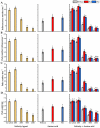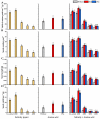Exogenously Supplemented Proline and Phenylalanine Improve Growth, Productivity, and Oil Composition of Salted Moringa by Up-Regulating Osmoprotectants and Stimulating Antioxidant Machinery
- PMID: 35736704
- PMCID: PMC9227737
- DOI: 10.3390/plants11121553
Exogenously Supplemented Proline and Phenylalanine Improve Growth, Productivity, and Oil Composition of Salted Moringa by Up-Regulating Osmoprotectants and Stimulating Antioxidant Machinery
Abstract
Salinity is linked to poor plant growth and a reduction in global food output. Therefore, there is an essential need for plant adaptation and mitigation of salinity stress conditions. Plants combat salinity stress influences by promoting a set of physiological, biochemical, and molecular actions. Tremendous mechanisms are being applied to induce plant stress tolerance, involving amino acid application. For evaluating the growth and productivity of Moringa oleifera trees grown under salt stress conditions, moringa has been cultivated under different levels of salinity and subjected to a foliar spray of proline (Pro) and phenylalanine (Phe) amino acids. Moringa plants positively responded to the lowest level of salinity as the leaves, inflorescences, seeds, and oil yields have been increased, but the growth and productivity slightly declined with increasing salinity levels after that. However, Pro and Phe applications significantly ameliorate these effects, particularly, Pro-treatments which decelerated chlorophyll and protein degradation and enhanced vitamin C, polyphenols, and antioxidant activity. A slight reduction in mineral content was observed under the high levels of salinity. Higher osmoprotectants (proline, protein, and total soluble sugars) content was given following Pro treatment in salted and unsalted plants. A significant reduction in oil yield was obtained as affected by salinity stress. Additionally, salinity exhibited a reduction in oleic acid (C18:1), linoleic (C18:2), and linolenic (C18:3) acids, and an increase in stearic (C18:0), palmitic (C16:0), eicosenoic (C20:2), and behenic (C22:0) acids. Generally, Pro and Phe treatments overcome the harmful effects of salinity in moringa trees by stimulating the osmoprotectants, polyphenols, and antioxidant activity, causing higher dry matter accumulation and better defense against salinity stress.
Keywords: abiotic stress; fatty acids; linoleic acids; moringa; oleic acid; proline; salinity.
Conflict of interest statement
The authors declare no conflict of interest.
Figures









Similar articles
-
Oil Yield and Bioactive Compounds of Moringa oleifera Trees Grown Under Saline Conditions.Plants (Basel). 2025 Feb 7;14(4):509. doi: 10.3390/plants14040509. Plants (Basel). 2025. PMID: 40006768 Free PMC article.
-
Salinity stress improves antioxidant potential by modulating physio-biochemical responses in Moringa oleifera Lam.Sci Rep. 2023 Feb 18;13(1):2895. doi: 10.1038/s41598-023-29954-6. Sci Rep. 2023. PMID: 36807545 Free PMC article.
-
Bacillus firmus (SW5) augments salt tolerance in soybean (Glycine max L.) by modulating root system architecture, antioxidant defense systems and stress-responsive genes expression.Plant Physiol Biochem. 2018 Nov;132:375-384. doi: 10.1016/j.plaphy.2018.09.026. Epub 2018 Sep 21. Plant Physiol Biochem. 2018. PMID: 30268029
-
Contribution of Exogenous Proline to Abiotic Stresses Tolerance in Plants: A Review.Int J Mol Sci. 2022 May 6;23(9):5186. doi: 10.3390/ijms23095186. Int J Mol Sci. 2022. PMID: 35563577 Free PMC article. Review.
-
Moringa oleifera Seeds and Oil: Characteristics and Uses for Human Health.Int J Mol Sci. 2016 Dec 20;17(12):2141. doi: 10.3390/ijms17122141. Int J Mol Sci. 2016. PMID: 27999405 Free PMC article. Review.
Cited by
-
Seed Disinfection Treatments Minimized Microbial Load and Enhanced Nutritional Properties of Fenugreek Sprouts Which Alleviated Diabetes-Negative Disorders in Diabetic Rats.Nutrients. 2024 Aug 10;16(16):2635. doi: 10.3390/nu16162635. Nutrients. 2024. PMID: 39203772 Free PMC article.
-
Integrated Action of Rhizobacteria with Aloe vera and Moringa Leaf Extracts Improves Defense Mechanisms in Hibiscus sabdariffa L. Cultivated in Saline Soil.Plants (Basel). 2023 Oct 25;12(21):3684. doi: 10.3390/plants12213684. Plants (Basel). 2023. PMID: 37960041 Free PMC article.
-
Effect of hexavalent chromium on growth performance and metabolism in broiler chicken.Front Vet Sci. 2023 Sep 26;10:1273944. doi: 10.3389/fvets.2023.1273944. eCollection 2023. Front Vet Sci. 2023. PMID: 37822955 Free PMC article.
-
Chemical application improves stress resilience in plants.Plant Mol Biol. 2025 Mar 19;115(2):47. doi: 10.1007/s11103-025-01566-w. Plant Mol Biol. 2025. PMID: 40105987 Free PMC article. Review.
-
Essential oils prolonged the cut carnation longevity by limiting the xylem blockage and enhancing the physiological and biochemical levels.PLoS One. 2023 Mar 7;18(3):e0281717. doi: 10.1371/journal.pone.0281717. eCollection 2023. PLoS One. 2023. PMID: 36881583 Free PMC article.
References
-
- Ramachandran C., Peter K.V., Gopalakrishnan P.K. Drumstick (Moringa oleifera): A multipurpose Indian vegetable. Econ. Bot. 1980;34:276–283. doi: 10.1007/BF02858648. - DOI
-
- Morton J.F. The horseradish tree, Moringa pterygosperma (Moringaceae) a boon to arid lands. Econ. Bot. 1991;45:318–333. doi: 10.1007/BF02887070. - DOI
-
- Rockwood J.L., Anderson B.G., Casamatta D.A. Potential uses of Moringa oleifera and an examination of antibiotic efficacy conferred by M. oleifera seed and leaf extracts using crude extraction techniques available to underserved indigenous populations. Int. J. Phytother. Res. 2013;3:61–71.
-
- El-Serafy R.S., El-Sheshtawy A.A., Abd El-Razek U.A., Abd El-Hakim A.F., Hasham M.M.A., Sami R., Khojah E., Al-Mushhin A.A.M. Growth, yield, quality, and phytochemical behavior of three cultivars of quinoa in response to moringa and Azolla extracts under organic farming conditions. Agronomy. 2021;11:2186. doi: 10.3390/agronomy11112186. - DOI
LinkOut - more resources
Full Text Sources

